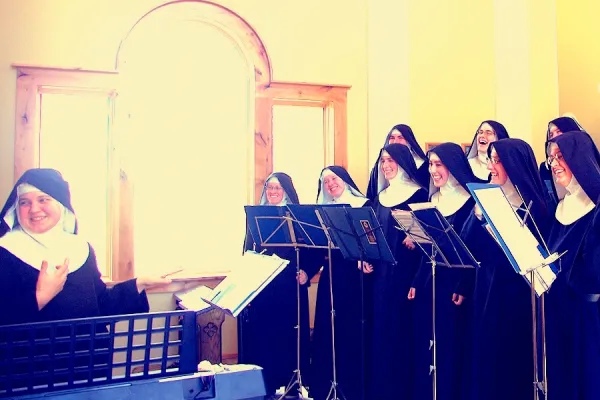Sr. Wilhelmina Lancaster, African American Foundress Whose Body is the Center of Attention

[ad_1]
When the local Catholic high school became segregated under the Christian Brothers and public school seemed like her only option, her parents went to great efforts to ensure that their daughter and her schoolmates could continue their Catholic education.
According to Sister Wilhelmina, as recounted in her biography, her “parents, who did not want me to go to the public high school, got to work and founded St. Joseph’s Catholic High School for Negroes, which lasted until Archbishop Ritter put an end to segregation in the diocese.”
She graduated as valedictorian of the school her parents helped to found and then entered the Oblate Sisters of Providence, one of only two religious orders for Black or Hispanic women. She would remain with these sisters for 50 years under vows.
The habit and the Traditional Latin Mass
During her 50 years in religious life, Sister Wilhelmina witnessed the changes brought by Vatican II and sought to preserve the habit, even constructing one of her own when the sisters stopped producing them.
(Story continues below)
“She spent so many years fighting for the habit,” said Mother Cecilia, who said Sister Wilhelmina took seriously the idea that the habit signifies the wearer as a bride of Christ.
According to her biography, she made a habit for herself, creating parts of the headdress out of a plastic bleach bottle even as her sisters no longer wore theirs.
As the Catholic Key reported, her homemade habit may have saved her life when she was working as a teacher in Baltimore and the stiff, high-necked collar known as the guimpe deflected the knife of a disgruntled student.
Her biography tells of an occasion when a sister passing her in the hallway pointed at the traditional headdress and asked, “Are you going to wear that all the time?”
“Yes!” Sister Wilhelmina responded and would later quip, “I am Sister WIL-HEL-MINA — I’ve a HELL of a WILL and I MEAN it!”
After years of trying to get her order to return to the habit, she happened to hear about the Priestly Fraternity of St. Peter starting a group of sisters, and she had rediscovered the Latin Mass and fell in love with it, Mother Cecilia said.
“And one day, she packed her bags — and she’s 70 years old, and she went to found this community — just a complete leap of faith.”
In 1995, with the help of a member of the Priestly Fraternity of St. Peter, the community began. Over time, it would take on a more contemplative and distinctly Marian charism, with a special emphasis on praying for priests.
In her proposal for a new community, Wilhelmina said she wanted to return to regular observance, something she petitioned for during the general chapter of the Oblate Sisters of Providence. “The wearing of a uniform habit, the surrendering of all monies to a common bursar, the obeying of lawful authority in all departments, the guarding of enclosure and of times and places of silence, and the living together an authentic fraternal life,” she wrote.
In short, in her new community, she imagined a return to the ordinary discipline of religious life.
The new community, which began in Scranton, Pennsylvania, followed St. Benedict in his Rule and chanted the traditional Divine Office in Latin. In 2006, the community accepted an invitation from Bishop Robert W. Finn to transfer to his Diocese of Kansas City-St. Joseph in Missouri.
In 2018, their abbey, Abbey of Our Lady of Ephesus, was consecrated with Mother Abbess Cecilia as the first abbess with Sister Wilhelmina under her authority. In 2019, seven sisters left the abbey to establish the order’s first daughter house, the Monastery of St. Joseph in Ava, Missouri.
Today, the sisters continue to lead lives of silence and contemplation, following St. Benedict’s Rule. They partake in the Extraordinary Form of the Mass and use the 1962 Monastic Office, with its traditional Gregorian Chant, in Latin.
 The community records an album in the St. John’s Chapel. . Benedictines of Mary, Queen of Apostles.
The community records an album in the St. John’s Chapel. . Benedictines of Mary, Queen of Apostles.
Devoted to the Blessed Mother
Sister Wilhelmina is remembered for her love of Our Lady, even in the last years of her life, when she was suffering from fragile health.
Regina Trout, a former postulant who cared for Sister Wilhelmina and is now married with children and a lecturer in biology at Purdue University Fort-Wayne, recalled seeing her visibly moved.
“Whenever you would talk to her about Our Lady, you could just see that spark. She loved Our Lady so much, and that came through so strongly,” she said.
Sister Wilhemina’s last conscious words — ”O Maria,” sung two days before her death as part of the hymn “O Sanctissima” — were a reflection of her deeply Marian piety as well as the charism of the chart-topping music that glorifies God that the Benedictine Sisters of Mary are known for.
“She loved our Blessed Mother,” Mother Cecilia said. “That’s what she would tell everybody coming here. Pray the rosary. Don’t forget to pray the rosary. Love the Blessed Mother. She loves you.”
“Her death was beautiful,” the abbess told EWTN’s ACI Group. “God arranged everything.”
“We were singing ‘Jesus, my Lord, my God, my all.’ When we got to the rest of the song — ’Had I but Mary’s sinless heart, with which to love Thee with, O what joy’ — she opened her eyes and looked up.
“I mean, she had been comatose. We know she could hear us, but she was just not responsive at all for a couple of days. And then she just looked up with this face full of bursts of love.”
For the abbess, it seemed like “she was just already in heaven” in those moments.
[ad_2]
Source link

